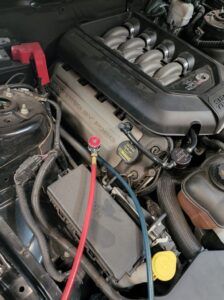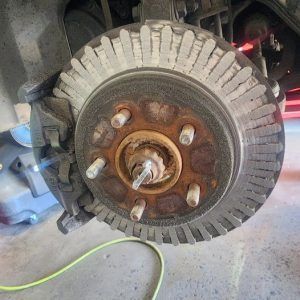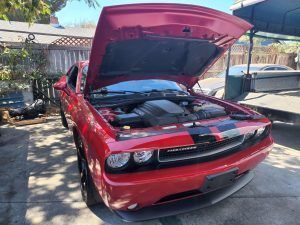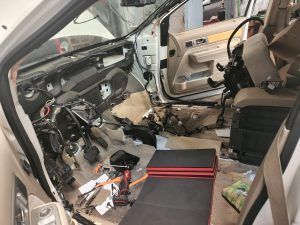Demystifying Car Brake Repair: A Look At The Basics
When it comes to keeping your car in top condition, the braking system is one of the most important components to maintain. After all, being able to stop your vehicle quickly and safely is crucial for your own safety and the safety of others on the road. However, many drivers are intimidated by the thought of brake repair, and may put off necessary maintenance or repairs as a result. But fear not – demystifying car brake repair is easier than you might think.
In this article, we’ll take a look at the basics of the braking system, including how it works and common issues that can arise. We’ll also walk you through the process of brake pad and fluid replacement, two essential maintenance tasks that can help keep your brakes in top shape. Finally, we’ll offer some tips for finding a reliable brake repair service in your area.
By the end of this article, you’ll have a better understanding of how your car’s brakes work, how to keep them in good condition, and what to do if problems arise.
Key Takeaways
– The braking system is crucial for vehicle safety and understanding its components is important.
– Common brake system issues include squeaking brakes, reduced braking power, and brake failure.
– Regular brake maintenance and choosing a reliable brake repair service are crucial for ensuring vehicle safety and performance.
– DIY brake repair should be avoided if not confident in skills, and safety should always be a top priority when it comes to brake repair.
Understanding the Basics of the Braking System
Now, you may be wondering, “How does the braking system actually work?”Well, let’s break it down for you.
The braking system is responsible for slowing down or stopping your car when you hit the brakes. It consists of several components, including the brake pedal, brake booster, brake master cylinder, brake lines, brake calipers, brake rotors, and brake pads.
The brake pads are the components in contact with the brake rotors, and they use friction to slow down or stop the car. Brake pad materials vary, and they can be made of organic, ceramic, or metallic materials. Each material has its advantages and disadvantages, but the most common type is the semi-metallic brake pad. These pads are made of a mixture of metallic and organic materials and offer good performance, durability, and affordability.
Brake rotor designs also vary, and they can be solid, vented, or slotted. Solid rotors are the simplest and most common type, and they are suitable for everyday driving. Vented rotors have vanes that allow air to circulate, which helps to dissipate heat and prevent brake fade. Slotted rotors have slots that help to remove gas and dust from the brake pad, which improves braking performance.
Understanding the basics of the braking system, including the brake pad materials and brake rotor designs, can help you identify and prevent common brake system issues.
Now that you know how the braking system works and the different components involved, it’s important to be aware of common brake system issues and how to address them.
Common Brake System Issues
If you notice your brakes are squeaking, it could be a sign of worn brake pads or rotors.
Reduced braking power can be caused by a variety of issues, such as air in the brake lines or a malfunctioning brake booster.
Brake failure is a serious issue that can be caused by a number of factors, including worn brake pads, leaking brake fluid, or a malfunctioning master cylinder.
It’s important to address any brake system issues as soon as possible to ensure your safety on the road.
Squeaking Brakes
Brakes that squeak can be a frustrating and alarming issue for any driver. However, this problem isn’t uncommon and can often be resolved with a few simple steps.
Brake noise analysis is the first step in diagnosing the cause of the squeaking. This involves a thorough inspection of the brake system to determine the source of the noise. The noise could be caused by worn brake pads or rotors, loose or damaged brake components, or a lack of lubrication.
Once the source of the noise has been identified, the appropriate repair can be made. In some cases, this may involve brake rotor resurfacing, which smooths out any rough or uneven spots on the rotor surface. This can help to reduce the noise and restore proper brake function.
If the problem persists, it may be necessary to replace the brake pads or other components. Squeaking brakes can be an early warning sign of reduced braking power, so it’s important to have any brake issues addressed as soon as possible to ensure safe driving.
Reduced Braking Power
Don’t let reduced braking power catch you off guard while driving. This is a serious issue that can put you and others on the road in danger. The main reasons for reduced braking power are improper maintenance and worn brake pads.
Here are three things to keep in mind:
1. If your brake pads are worn down to less than 1/8 inch, they need to be replaced immediately. Otherwise, you risk damaging your rotors and reducing your braking power even further.
2. Check your brake fluid regularly to ensure it’s at the proper level. Low brake fluid can cause reduced braking power and even complete brake failure.
3. If your brake pedal feels spongy or goes all the way to the floor, you may have air in your brake lines. This can be caused by improper bleeding of the brake system or a leak in the brake lines.
Reduced braking power can lead to brake failure, which is a dangerous situation that can cause accidents. In the next section, we’ll discuss the signs of brake failure and what to do if it occurs.
Brake Failure
You never want to experience brake failure while driving, it can be a terrifying situation that requires quick thinking and action. Brake failure occurs when the brake pedal loses its pressure or doesn’t respond when pressed down. This can happen due to various reasons, such as a leak in the brake system, worn-out brake pads, or faulty brake lines.
There are warning signs that can indicate impending brake failure, such as squeaking or grinding noises when applying the brakes, vibrations or pulsations felt in the brake pedal or steering wheel, and a longer stopping distance than usual. If you notice any of these signs, it’s crucial to get your brakes checked immediately by a professional mechanic.
Remember, it’s better to be safe than sorry when it comes to brake failure.
In the next section, we’ll look at brake pad replacement, which is one of the most common brake repairs.
Brake Pad Replacement
When it’s time to swap out your brake pads, it’s like saying goodbye to an old friend who’s served you well on your daily commute. However, it’s important to know when it’s time to let go and replace your brake pads.
Signs of worn brake pads include screeching or squealing noises, reduced braking performance, and a vibrating brake pedal. If you notice any of these signs, it’s time to replace your brake pads.
To replace your brake pads, you’ll need a few tools, including a lug wrench, a C-clamp, and a brake piston tool. Here’s a step-by-step guide to help you complete your DIY brake pad replacement:
1. Loosen the lug nuts on the wheel with the brake pads you plan to replace.
2. Jack up the car and remove the wheel.
3. Locate the brake caliper and remove the two bolts that hold it in place.
4. Use the C-clamp to compress the brake piston back into the caliper.
5. Remove the old brake pads and install the new ones.
6. Replace the caliper and the two bolts you removed earlier.
7. Put the wheel back on and tighten the lug nuts.
With your new brake pads installed, it’s important to keep your brake system in good working order by regularly checking and replacing your brake fluid.
Brake Fluid Replacement
To keep your brakes functioning properly, it’s important to regularly replace your brake fluid. Brake fluid is a hydraulic fluid that transfers pressure from the brake pedal to the brake components. Over time, brake fluid can become contaminated with moisture, dirt, and debris, which can affect its ability to transfer pressure effectively.
There are two types of brake fluid: DOT 3 and DOT 4. DOT 3 is the most commonly used brake fluid, while DOT 4 is a higher grade fluid that provides better braking performance. It’s important to use the correct type of brake fluid for your vehicle, as using the wrong type can cause damage to your brake system. Be sure to check your vehicle’s owner manual for the recommended type of brake fluid.
In addition to regular brake pad replacement, it’s also important to flush and replace your brake fluid every 2-3 years. Brake fluid flushing involves removing all of the old brake fluid and replacing it with fresh fluid. This is important because old brake fluid can contain contaminants that can cause corrosion and damage to the brake system. Flushing the brake fluid can also improve the performance of your brakes.
To ensure that your brake system is properly maintained, it’s best to have a reliable brake repair service perform this task for you. Replacing your brake fluid is an important part of maintaining the safety and performance of your vehicle’s braking system. Now that you understand the importance of brake fluid replacement, let’s take a look at finding a reliable brake repair service.
Finding a Reliable Brake Repair Service
Finding a dependable brake repair service can be like discovering a mechanic who can sniff out the problem in your car engine with a single whiff.
It’s essential to choose a reliable brake repair service that can provide you with quality work at a reasonable cost. To find a trustworthy shop, check the reviews online, ask for recommendations from friends and family, and make sure they have certifications and experience in brake repair.
Cost considerations are also crucial when choosing a brake repair service. While it’s tempting to go for the cheapest option, keep in mind that quality work may come at a higher price. Make sure to ask for a detailed estimate of the repair costs before committing to a service.
A reputable shop will explain the work that needs to be done and the parts that need to be replaced, as well as provide an estimated cost for each. DIY brake repair may seem like a cost-effective option, but it’s essential to have the necessary knowledge and tools before attempting any repairs.
If you’re not confident in your skills, it’s best to leave it to the professionals. Not only can improper repairs cause further damage to your brakes, but they can also put your safety at risk. When it comes to brake repair, it’s better to be safe than sorry.
Frequently Asked Questions
How often should brake pads be replaced?
Replace your brake pads when they reach their lifespan, determined by the manufacturer’s specifications. Additionally, if you hear a high-pitched squeal or notice the wear indicators, replace them immediately to avoid damaging your rotors.
What are the signs of a failing brake master cylinder?
If your brake master cylinder is failing, you may notice a spongy brake pedal or a loss of braking power. Bleeding brakes may temporarily fix the issue, but replacement is necessary for long-term safety.
Can brake fluid be topped off or does it need to be completely replaced?
To maintain brake fluid, top it off as needed and replace it every 2-3 years. Contamination can occur from moisture or debris, so regularly check for a clear, amber color.
What is the average cost of brake repair services?
The average cost of brake repair services varies depending on several factors. DIY repairs may be cheaper, but professional repair options offer more expertise and better quality. Factors affecting cost include the type of brake system, the extent of damage, and the cost of replacement parts.
How long does a brake job typically take to complete?
A typical brake job timeline is between 1-2 hours per axle, depending on the mechanic’s recommendations. This includes inspection, removal, and replacement of brake pads, rotors, and calipers.
Conclusion
Congratulations! You now have a better understanding of the basics of car brake repair. By comprehending the fundamental components of a braking system and the common issues that arise, you’ll be able to diagnose and solve any potential problems efficiently.
To recap, brake pads and brake fluid are crucial components that require periodic replacement to keep your vehicle’s braking system operating optimally. If you notice any red flags, like squeaking or grinding noises, or a spongy brake pedal, it’s time to get your brakes checked by a reliable repair service.
Taking care of your brakes will ensure not only your safety but also the longevity of your vehicle.
Remember, when it comes to car brake repair, it’s always best to be proactive rather than reactive. By keeping up with regular maintenance, you’ll avoid costly repairs down the road and stay safe on the road.
So, keep an eye out for any warning signs and don’t hesitate to take your vehicle to a trusted brake repair specialist.







